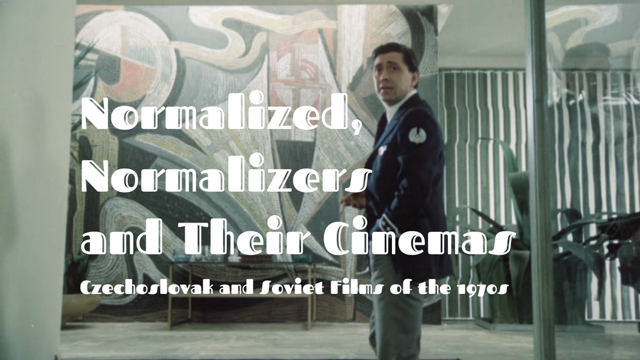The normalized, the normalizers and their cinemas: Czechoslovak and Soviet Films of the 1970s
Date: May 13, May 27, June 4, 2024 at 4:30 pm (CET)
Language: English
Program
Every session will take place from 4.30 to 6 PM Prague/Paris time and will include a presentation and a discussion.
Monday, May 13
The Squalid Charms of the Stagnation Cinematic Aesthetics
Igor GULIN (independent cultural historian, critic, poet)
Monday, May 27
Visitors and Insiders: The Normalisation-Era Career of Jindřich Polák
Jonathan OWEN (independent scholar of Eastern and Central European cinema, avant-gardes, and cult film; author, Avant-Garde to New Wave: Czechoslovak Cinema, Surrealism and the Sixties, 2011)
Tuesday, June 4
Czechoslovak public relations films for export
Lucie ČESÁLKOVÁ (editor-in-chief, Iluminace magazine; Charles University, Prague)
Abstract
While the Moscow-led invasion of Czechoslovakia in August 1968 puts an end to the short period of relative liberalization known as Prague Spring and changes the face of Czechoslovak cinema, the Brezhnev-era Soviet film industry is experiencing a transformation of its own. State-run Czechoslovak studios of the “offensive normalization” period are seeing the return of both party censorship and socialist realist aesthetics. Meanwhile the Soviet feature film is moving further away from both the Thaw-era experiments and the grand style and themes associated with it in previous decades.
Thus, while Soviet dramas and comedies are increasingly turning towards the everyman—and woman—and the intimate sphere, major studios in Prague and Bratislava release high-budgeted or pathos-laden epics on WW2 or Czechoslovak Communist Party hagiography. Yet adaptations of literary classics, burlesque comedies, films for youth or crime thrillers sometimes disguised as war dramas are equally popular in both countries.
In both cinemas—that of the “normalizer” and that of the “normalized”—the political and economic stagnation reinforced by stochastic censorship and disillusioned society often leads to peculiar examples of mismatched ideology and aesthetics allowing for viewing them as accidental camp classics today. What structural changes do Czechoslovak studios undergo in the wake of the Warsaw Pact invasion? What thematic and aesthetic choices can be attributed to their moment in film history on both sides of the Iron Curtain? How does the soaring number of light entertainment genre like melodrama, comedy or musical correlate with the current events? Last but not least, the questions of actors’ agency in the face of state repression and censorship, of reevaluation of the immense corpus of films created during the late-Communist era feel relevant in Russian and Central European cinema and culture in general today.

